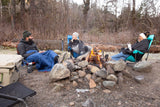What to Know When Buying a Sleeping Bag

With the weather changing from sunshine to snow, we must bid farewell to the crisp autumn air and say hello to colder temps and wetter weather. As the trees drop the last of their leaves, our eyes are drawn outside as we are once again reminded of the beauty of our seasonal surroundings. But the romance of outdoor exploration can quickly be stripped away by neglecting the importance of what’s keeping you warm when sleeping away in your bed, namely your sleeping bag. Regardless of your level of expertise, sleeping bags can seem scientific and intimidating with their different temperature ratings, materials, weights and shapes. This short guide will shed light on the specs that matter the most and should help to demystify the process of buying a new sleeping bag.
Temperature Ratings
Let’s start with the main factor in sleeping bag warmth: temperature rating. A sleeping bag’s temperature rating (as indicated by the “EN” rating scale for CMT bags) is the lowest temperature at which it will keep the average sleeper comfortably warm. In other words, a 30º bag should keep the average sleeper warm in temperatures as low as 30° Fahrenheit. That said, there is currently no standard within the U.S. to measure these ratings and there are many variables that a rating lab would not be able to simulate, such as metabolism, what you’re wearing, sleeping pad material/ thickness, or the fact that most women tend to sleep colder than men. The following list outlines a rough guide regarding which temperature rating is appropriate for which season. NOTE: Please keep your own regional climate in mind, as seasonal temperatures differ significantly throughout the U.S.

Which temperature rating do you really need?
- Indoor sleepovers: 45° and up
- Summer outdoor tent camping: 30° and up
- Fall/Spring outdoor tent camping: 20° to 30°
- Winter tent camping: 0° to 20°
- Deep Winter Expeditions: -40ºF to 20ºF
We are skeptical of the idea of a four-season sleeping bag because the change in temps over those four seasons vary greatly. What will keep you adequately warm in frigid winter months will most likely be much warmer than you might want for summer camping, so a one-size-fits-all approach is difficult to achieve. It’s important to approach each trip anew. Fall camping at high elevation? Might want to pack your 0º bag. Winter on a tropical beach? Your 30º should be plenty warm. As a rule of thumb, give yourself a 5-10º buffer between your bag's temperature rating and how low the temperature will actually get. If it’s getting down to 40º at night, you should at least pack your 30º bag. If it’s getting down under 30º you might consider your 0º bag to make sure you stay toasty. Of course, there are other factors beyond your bag’s temperature rating that also affect how warm you will be during a night outdoors.

Sleeping Pads & Other Factors
It’s natural to think that the colder it is, the warmer your sleeping bag needs to be. While it’s always better to be safe than sorry, it’s also important to note the various factors that impact warmth. Your body produces heat and a sleeping bag acts as a thermos, making sure the heat can’t escape. Ground temperature also plays a major role in how warm you will be in your sleeping bag. You’re bound to be more affected by the ground temperature than the temperature of the air around you, which brings us to your sleeping bag’s most trusted companion: the sleeping pad.
A sleeping pad keeps you off the ground, preventing whatever bramble or stone you might have set up your tent on from poking you while you’re snoozing. It also keeps you insulated from the cold ground, which would otherwise continue to suck warmth from your body until it was the same temperature as the surface of the earth. As previously mentioned, air temperature affects you less than ground temperature, and putting just a little air between you and the ground will keep you much warmer. For example, a pad like the Cascade Mountain Tech Sleeping Pad puts 2.5” of air and pad material between you and the ground, insulating you while resisting any moisture that might build up during your slumber in verdant meadows or grassy hills.

Material: Synthetic vs Down
When talking about insulation, the two options you’ll hear the most about are down and synthetic. Below are quick summaries of each.
Synthetic
With synthetic insulation, you don’t have to worry about moisture ruining a good night’s sleep. Synthetic material continues to provide warmth when damp and also dries out much quicker than down. Synthetic is also generally more durable than down. Although you tend to save money by purchasing a synthetic bag, the lifespan isn’t quite as long as that of a down bag since the material can pack down over time, which reduces the maximum insulating potential. For the average camper, synthetic is plenty warm and durable, which is part of the reason why we chose to design our bags with 100% recycled Polyester eco-friendly synthetic insulation. For those who don’t find themselves camping in cold situations, we recommend the Cascade Mountain Tech Adventure 30° Mummy Sleeping Bag, designed with durability, performance and the environment in mind. Those who might find themselves in freezing scenarios should consider the Adventure 0° Mummy Sleeping Bag.
|
Pros:
|
Cons:
|
Down
Down bags pack down more slowly over time, giving them a longer insulation lifespan. You can stuff your sleeping bag into its sack over and over and it will eventually bounce back to life. Down also tends to be more compressible than synthetic, so you can pack it into a smaller space–good for the space conscious backpacker. The biggest drawback of down is that if it gets wet, the material loses most of its insulating power instantly. This is a quick way to ruin a camping trip. Many shoppers also find themselves ethically conflicted when considering a down option because of how the feathers are sourced.
|
Pros:
|
Cons:
|

Shape, Size & Features
Just like people, sleeping bags come in all different shapes and sizes and have different characteristics that provide a range of benefits... Here are a few things to consider before you make your next purchase.
- Shape - The cut, or shape, of your sleeping bag plays a huge role in the weight and overall warmth. By far the most popular shape is the mummy cut, and for good reason. It generally packs down smaller and improves warmth due to its snug fit and signature hood. While the extra room offered from more rectangular bags can make it easier for side-sleepers to move around during the night, they can also make bags feel drafty and sleep colder. We felt that the mummy shape was the best overall choice for our bags due to these factors. It also tends to weigh less overall, saving you precious weight in your backpack.
- Toe Box - If you’ve got long feet and have ever slept with sheets that were tucked tightly into the foot of the bed, you know how uncomfortable it can be to have so much pressure pulling and stretching your feet downward. The same can be said about many snug sleeping bags, especially those with a mummy design, where the top and bottom material are simply sewn together without consideration for the needs of your feet! Cascade Mountain Tech’s Adventure Sleeping Bags feature a toe box with a raised, roomier fit, allowing those with up to size 12 (M) feet extra wiggle room without sacrificing the overall length of your bag.
- Draft Collars & Cinch Hood - Staying warm during cold nights requires keeping the warm air inside of a sleeping bag from escaping. That’s where features like draft collars, zipper draft tubes, and cinch hoods come in. A draft collar is a tube of fabric with additional insulation that can be positioned around your shoulders and the base of your neck to prevent heat from escaping when you move around at night. Zipper draft tubes line the inside of your zipper to make sure that air isn't escaping through the zipper teeth. A cinch hood allows you to tighten up the opening around your head to make sure your noggin is snugly wrapped.
- Zippers - Another critical feature to consider when shopping for sleeping bags is the zippers. Zippers play an important role in making your nights outdoors as comfortable as possible because they allow for adjustability. A bag with a dual zipper allows for ventilation near the feet should your bag get too warm and allows you to easily crawl out of your bag should nature call in the middle of the night.
- Sizing - The average sleeping bag will fit most people. That said, if you are much larger or smaller than the average human, you might consider shopping for a sleeping bag that comes in a more specific size. Too much space inside your bag can affect its performance, and the same can be said about an extremely tight bag.
- Other Features - Beyond the features that are more necessary for warmth, there are others that add value in terms of convenience or comfort. Look for things like stash pockets, integrated pillow pockets, and sleeping pad straps, all of which are included in our line of Adventure Sleeping Bags.
By now you hopefully have a better understanding of the world of sleeping bags, but that doesn’t mean you can’t research further. We encourage you to check out the specs of our Adventure Sleeping Bags and to reach out if any questions arise.






Comments
dana wilson said:
nice article on sleep bag temps Emily/Evelyn!